Canon 8155B004, 8152B005 User Manual
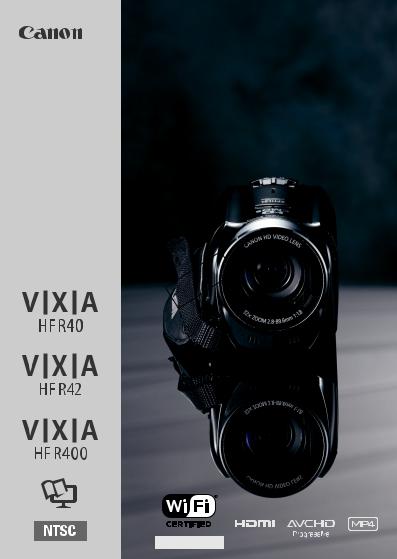
PUB. DIE-0431-000
HD Camcorder
Instruction Manual
COPY
64
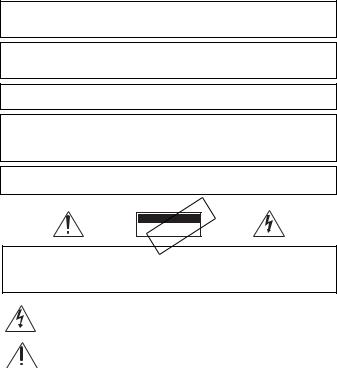
Important Usage Instructions
WARNING
TO REDUCE THE RISK OF FIRE OR ELECTRIC SHOCK, DO NOT EXPOSE THIS PRODUCT TO RAIN OR MOISTURE.
COPYRIGHT WARNING:
Unauthorized recording of copyrighted materials may infringe on the rights of copyright owners and be contrary to copyright laws.
The Mains plug is used as the disconnect device. The Mains plug shall remain readily operable to disconnect the plug in case of an accident.
CAUTION:
•Danger of explosion if the wrong type of batteries are attached. Use only the same type of batteries.
•Do not expose batteries or product to excessive heat such as the inside of a car under direct sunlight, fire, etc.
While using the compact power adapter, do not wrap it or cover it with a piece of cloth, and do not place it in confined narrow spaces.
RISK OF ELECTRIC SH CK
COPYCAUTION
DO N T PEN
CAUTION:
TO REDUCE THE RISK OF ELECTRIC SHOCK, DO NOT REMOVE COVER (OR BACK). NO USER-SERVICEABLE PARTS INSIDE. REFER SERVICING TO QUALIFIED SERVICE PERSONNEL.
The lightning flash with arrowhead symbol, within an equilateral triangle, is intended to alert the user to the presence of uninsulated “dangerous voltage” within the product’s enclosure, that may be of sufficient magnitude to constitute a risk of electric shock to persons.
The exclamation point, within an equilateral triangle, is intended to alert the user to the presence of important operating and maintenance (servicing) instructions in the literature accompanying the product.
2
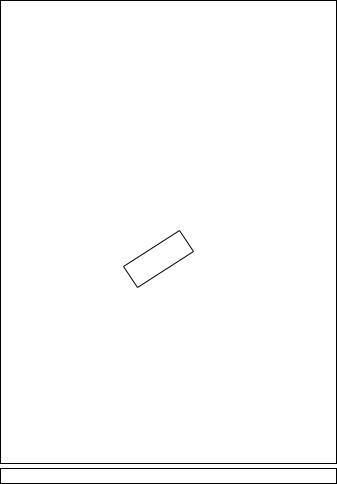
FCC/IC NOTICE
HD Camcorder, VIXIA HF R42 / VIXIA HF R40 / VIXIA HF R400 systems
This device complies with Part 15 of the FCC Rules. Operation is subject to the following two conditions:
(1) This device may not cause harmful interference, and (2) this device must accept any interference received, including interference that may cause undesired operation.
Note: This equipment has been tested and found to comply with the limits for class B digital device, pursuant to Part 15 of the FCC Rules. These limits are designed to provide reasonable protection against harmful interference in a residential installation. This equipment generates, uses and can radiate radio frequency energy and, if not installed and use in accordance with the instructions, may cause harmful interference to radio communications. However, there is no guarantee that interference will not occur in a particular installation. If this equipment does cause harmful interference to radio or television reception, which can be determined by turning the equipment off and on, the user is encouraged to try to correct the interference by one or more of the following measures:
•Reorient or relocate the receiving antenna.
•Increase the separation between the equipment and receiver.
•Connect the equipment into an outlet on a circuit different from that to which the receiver is connected.
•Consult the dealer or an experienced radio/TV technician for help.
Use of shielded cable is required to comply with class B limits in Subpart B of Part 15 of FCC Rules. Do not make any changes or modifications to the equipment unless otherwise specified in the manual. If such changes or modifications should be made, you could be required to stop operation of the equipment.
Model ID0019 (including WLAN Module Model WM217, FCC ID: AZD217)
This device complies with Industry CanadaCOPYlicense-exempt RSS standard(s). Operation is subject to the following two conditions: (1) this device may not cause interference, and (2) this device must accept any interference, including interference that may cause undesired operation of the device.
This transmitter must not be co-located or operated in conjunction with any other antenna or transmitter.
The available scientific evidence does not show that any health problems are associated with using low-power wireless devices. There is no proof, however, that these low power wireless devices are absolutely safe. Low-power wireless devices emit low levels of radio frequency energy (RF) in the microwave range while being used. Whereas high levels of RF can produce health effects (by heating tissue), exposure to low-level RF that does not produce heating effects causes no known adverse health effects. Many studies of low-level RF exposures have not found any biological effects. Some studies have suggested that some biological effects might occur, but such findings have not been confirmed by additional research. This model has been tested and found to comply with FCC/IC radiation exposure limits set forth for an uncontrolled equipment and meets the FCC radio frequency (RF) Exposure Guidelines in Supplement C to OET65 and RSS-102 of the IC radio frequency (RF) Exposure rules.
Canon U.S.A., Inc.
One Canon Park, Melville, NY 11747, USA
Tel No. 1-800-OK-CANON (1-800-652-2666)
This Class B digital apparatus complies with Canadian ICES-003.
3
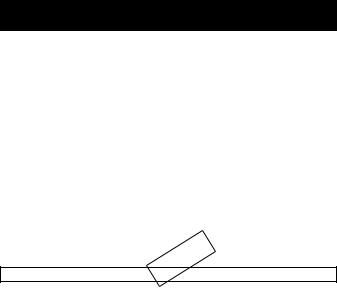
IMPORTANT SAFETY INSTRUCTIONS
In these safety instructions the word “apparatus” refers to the Canon HD Camcorder VIXIA HF R42 / VIXIA HF R40 / VIXIA HF R400 and all its accessories.
1 Read these instructions.
2 Keep these instructions.
3Heed all warnings.
4Follow all instructions.
5 Do not use this apparatus near water.
6Clean only with dry cloth.
7Do not install near any heat sources such as radiators, heat registers, stoves, or other apparatus (including amplifiers) that produce heat.
8Protect the power cord from being walked on or pinched particularly at plugs, convenience receptacles, and the point where they exit from the apparatus.
9Only use attachments/accessories specified by the manufacturer.
10Unplug this apparatus during lightning storms or when unused for long periods of time.
11Refer all servicing to qualified service personnel. Servicing is required when the apparatus has been damaged in any way, such as power-supply cord or plug is damaged, liquid has
been spilled or objects have fallen into the apparatus, the apparatus has been exposed to rain or moisture, does not operate normally,COPYor has been dropped.
4
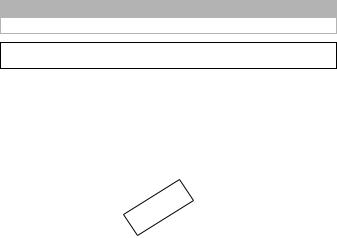
REGIONS OF USE
VIXIA HF R42 and VIXIA HF R40 are in compliance (as of January 2013) with the radio signal regulations of the regions listed below. For details on other regions where they can be used, make inquiries with the contacts listed on the back side of this instruction manual.
REGIONS
Canada, Hong Kong S.A.R., USA, South Korea, Taiwan
Model
ID0019: VIXIA HF R40 / VIXIA HF R42
COPY
5
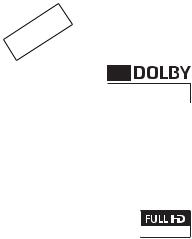
Trademark Acknowledgements
•SD, SDHC and SDXC Logos are trademarks of SD-3C, LLC.
•Microsoft and Windows are trademarks or registered trademarks of Microsoft Corporation in the United States and/or other countries. COPY
•App Store, iPad, iPhone, iTunes and Mac OS are trademarks of Apple Inc., registered in the U.S. and other countries.
•HDMI, the HDMI logo and High-Definition Multimedia Interface are trademarks or registered trademarks of HDMI Licensing LLC in the United States and other countries.
•“AVCHD”, “AVCHD Progressive” and the “AVCHD Progressive” logo are trademarks of Panasonic Corporation and Sony Corporation.
•Manufactured under license from Dolby Laboratories. 



 “Dolby” and the double-D symbol are trademarks of Dolby Laboratories.
“Dolby” and the double-D symbol are trademarks of Dolby Laboratories. 






•Google, Android, Google Play, YouTube are trademarks of Google Inc.
•Facebook is a registered trademark of Facebook, Inc.
•IOS is a trademark or registered trademark of Cisco in the U.S. and other countries and is used under license.
•The Twitter name and marks are trademarks of Twitter, Inc.
•Wi-Fi is a registered trademark of the Wi-Fi Alliance.
•Wi-Fi Certified, WPA, WPA2, and the Wi-Fi Certified logo are trademarks of the Wi-Fi Alliance.
•WPS as used on the camcorder’s settings, onscreen displays and in this manual signifies Wi-Fi Protected Setup.
•The Wi-Fi Protected Setup Identifier Mark is a mark of the Wi-Fi Alliance.
•Other names and products not mentioned above may be trademarks or registered trademarks of their respective companies.
•This device incorporates exFAT technology licensed from Microsoft.
•“Full HD 1080” refers to Canon camcorders compliant with high-definition video
composed of 1,080 vertical pixels (scanning lines). 

•This product is licensed under AT&T patents for the MPEG-4 standard and may be used
for encoding MPEG-4 compliant video and/or decoding MPEG-4 compliant video that was encoded only (1) for a personal and non-commercial purpose or (2) by a video provider licensed under the AT&T patents to provide MPEG-4 compliant video. No license is granted or implied for any other use for MPEG-4 standard.
6
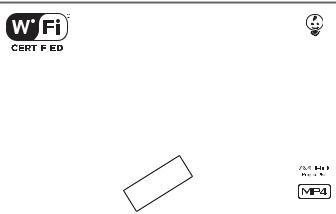
Exciting Features and New Functions
6/4 |
Baby Mode (A64) |
|||||||
|
|
|
|
|
|
Wi-Fi Functions |
||
|
|
|
|
|
|
|
||
|
|
|
||||||
|
|
|
|
|
|
(A122) |
Using Baby mode, you will not |
|
|
|
|
|
|
|
|
||
|
|
|
|
|
|
|
miss out on baby’s precious |
|
Enjoy the freedom of Wi-Fi* by |
moments. The camcorder’s |
|||||||
settings are optimized to capture |
||||||||
using convenient Wi-Fi functions |
||||||||
the beauty of baby’s skin. You |
||||||||
such as the following. |
||||||||
can also add stamps to the video |
||||||||
|
|
|
|
|
|
|
||
• You can use a smartphone as a |
to keep track of baby’s growth. |
|||||||
|
||||||||
remote control and record mov- |
|
|||||||
ies from a distance (A125). |
|
|||||||
• You can wirelessly connect the |
AVCHD and MP4 |
|||||||
camcorder to your home net- |
||||||||
Recording (A60) |
||||||||
work and upload your record- |
||||||||
ings to CANON iMAGE |
|
|
GATEWAY (A130). This COPYwill |
||
allow you to even share your |
|
When you record movies, you |
|
have the freedom to choose |
|
videos on YouTube and Face- |
|
|
|
whether the movie is in AVCHD or |
|
book. You can share your videos |
|
|
|
MP4 format. Record movies in |
|
on YouTube and Facebook also |
|
|
|
AVCHD and play them back with |
|
by uploading them using an iOS |
|
|
|
fantastic picture quality. |
|
device (A128). |
|
|
|
Alternatively, record movies in |
|
• Enjoying your recordings with |
|
|
|
MP4 for uploading to the Web and |
|
family and friends has just |
|
|
|
transferring to mobile devices. |
|
become easier because you can |
|
|
|
When you use the highest video |
|
use the Web browser on a |
|
|
|
quality setting for AVCHD |
|
smartphone or computer to view |
|
|
|
(28 Mbps) and MP4 movies |
|
the camcorder’s recordings |
|
|
|
(35 Mbps), you can record at 60 |
|
(A126). |
|
|
|
frames per second. With video at |
|
* Wi-Fi is a connection method for |
|
|
|
60 frames per second, your videos |
|
devices to connect wirelessly and is |
|
|
|
will achieve a level of realistic |
|
certified by the Wi-Fi Alliance. |
|
|
|
movement that will impress your |
|
|
|
|
|
|
audience. |
|
|
|
7
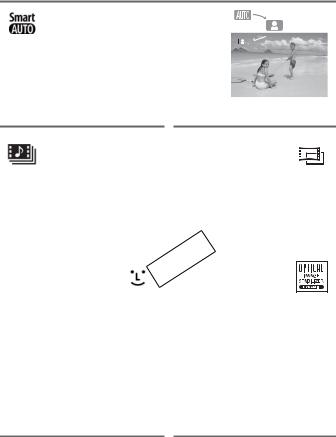
Smart AUTO (A43)
Smart AUTO automatically selects the best scene mode for the scene you want to shoot. You get spectacular recordings every time without worrying about settings.
Video Snapshot |
Cinema-Look Filters |
(A74) |
(A65) |
Shoot or capture short scenes and arrange them into a video clip set to your favorite background music.
Use professional cinema-look filters to create unique movies with distinctive looks.
|
|
|
(A76) |
COPY |
|
Face Detection |
|
Image Stabilization |
|
|
|
The camcorder automatically detects people’s faces and adjusts the focus and other settings accordingly for beautiful results.
Dynamic IS (A75) compensates for camcorder shake when you shoot video while walking. Powered IS
(A76) will produce stable shots when you zoom in on distant subjects (full telephoto). Intelligent IS (A45) selects the type of image stabilization for the recording situation.
8
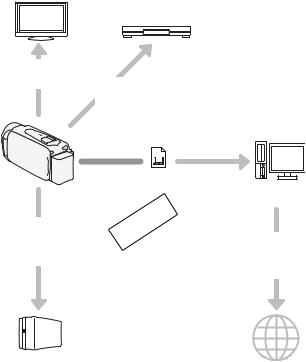
Enjoying Your Recordings on Other Devices
Connect the camcorder
to an HDTV (A105).
Copy your recordings to an external video recorder (A119).
Upload recordings to your computer (A111).
Copy the camcorder’s entire |
COPY |
|
|
memory onto an external |
|
hard drive (A116). |
|
Save your recordings.
Upload your MP4 movies and photos to the Web (A121).
9
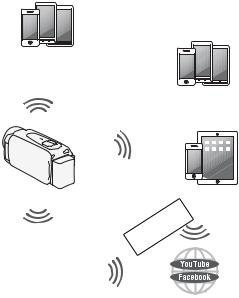
6/4
Enjoying Your Recordings Using the Camcorder’s Wi-Fi Functions
Use your iOS or Android smartphone or tablet to remotely view to remotely
control the camcorder (A125).
Use the Web browser on your iOS or Android smartphone or tablet the recordings on the camcorder (A126).
|
|
|
Save your recordings on an |
|
|
|
iPhone or iPad and play them |
|
|
|
back (A128). |
|
|
|
COPY |
|
|
|
|
|
|
|
After connecting the |
Connect the camcorder to an |
|||
access point on your home |
camcorder to an iPhone, iPad |
||
network and then share your |
or CANON iMAGE GATEWAY, |
||
recordings on CANON iMAGE |
you can upload your |
||
GATEWAY (A130). From |
recordings to other sites. |
||
there, you can make online |
|
||
|
albums to enjoy your |
|
|
|
recordings. |
|
|
10
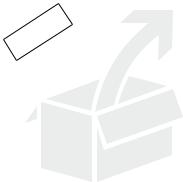
Table of contents
Introduction
7 Exciting Features and New Functions
15 About this Manual
17Getting to Know the Camcorder
17Supplied Accessories and CD-ROM
19Names of Parts
Preparations
21Getting Started
21 Charging the Battery Pack
23Turning On the Camcorder
24Using the GripCOPYBelt
25Opening the Lens Cover and Adjusting the LCD Screen
27 Memory Cards Compatible for Use with the Camcorder
29 Inserting and Removing a Memory Card
31 First Time Settings
31 Basic Setup
33 Changing the Time Zone
33 Initializing the Memory
35 Basic Operation of the Camcorder
35 Using the Touch Screen
35 Using the Menus
39 Operating Modes
Table of contents 11
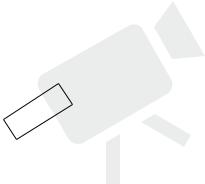
Basic Shooting and Playback
41 |
Basic Recording |
41 |
Shooting Video |
43 |
About the Smart AUTO function |
45Intelligent IS
46Taking Photos
47Zooming
50Basic Playback
50Playing Back Video
54Viewing Photos
56Deleting Scenes
58Deleting Photos
Advanced Shooting
60Selecting the Movie Format (AVCHD/MP4)
60Selecting the Video Quality
636/4Selecting the Memory (Built-in Memory/ Memory Card) for Recordings
636/4DualCOPYRecording and Relay Recording
64Baby Mode
65Cinema Mode and Cinema-Look Filters
66 Special Scene Modes
68Programmed AE Mode: Adjusting Settings to Match Your Needs
69Decoration: Adding a Personal Touch
74Video Snapshot
75Advanced Image Stabilization
76Powered IS
76 Face Detection and Tracking
78Faders
79Adjusting the Exposure
81Adjusting the Focus
82Pre-Recording
83White Balance
84Self Timer
85Frame Rate
86Tele Macro
12 Table of contents

87 Audio Scenes
87Audio Recording Level
89Using Headphones
90Using an External Microphone
Advanced Playback and Editing
92Capturing Video Snapshot Scenes and Photos from a Movie
93Playing Back Scenes in the Baby Album
94Playing Back Video Snapshot Scenes
95Playback with Background Music
97 Selecting the Playback Starting Point
99Dividing Scenes
100Trimming Scenes
100 Slideshow
External Connections
102 |
Terminals on the Camcorder |
103 |
COPY |
Connection Diagrams |
|
105 |
Playback on a TV Screen |
107 Saving and Sharing Your Recordings
1076/4Copying Movies and Photos to a Memory Card
1106/4Converting Movies to MP4 Format
111Saving Recordings on a Computer
1166/4Memory Save: Saving an Entire Memory onto an External Hard Drive
119 Copying Recordings to an External Video Recorder
121 Uploading MP4 Movies and Photos to the Web
Table of contents 13

6/4Wi-Fi Functions
122 Introduction to Wi-Fi
125Recording Movies Using a Smartphone as a Remote Control
126Remote Browse: Viewing Recordings Using a Web Browser on Your iOS Device or Android Smartphone
128 Uploading Videos Using an iOS Device
130Sharing Recordings with CANON iMAGE GATEWAY
136Playback on a Computer
137Wi-Fi Connection Using an Access Point
141Viewing and Changing Wi-Fi Settings
Additional Information
144Appendix: Menu Options Lists
144 [ 
 Main Functions] and [Edit] Panels 146 [
Main Functions] and [Edit] Panels 146 [ 
 Other Settings] Menus
Other Settings] Menus
154 Appendix: Onscreen Icons and Displays
158 |
Trouble? |
158 |
Troubleshooting |
164 |
List of Messages |
174 |
Do’s and Don’ts |
COPY 
174 Handling Precautions
178Maintenance/Others
179Using the Camcorder Abroad
180General Information
180Accessories
181Optional Accessories
185 |
Specifications |
190 |
Index |
14 Table of contents

About this Manual
Thank you for purchasing the Canon VIXIA HF R42 / VIXIA HF R40 / VIXIA HF R400. Please read this manual carefully before you use the camcorder and retain it for future reference. Should your camcorder fail to operate correctly, refer to Troubleshooting (A158).
Conventions Used in this Manual
• IMPORTANT: Precautions related to the camcorder’s operation.
IMPORTANT: Precautions related to the camcorder’s operation.
• NOTES: Additional topics that complement the basic operating procedures.
NOTES: Additional topics that complement the basic operating procedures.
• POINTS TO CHECK: Restrictions or requirements regarding the function described.
POINTS TO CHECK: Restrictions or requirements regarding the function described.
•A: Reference page number within this manual.
•6: Text that applies only to the models shown in the icon.
•The following terms are used in this manual:
When not specified as “memory card” or “built-in memory”, the term “memory” by itself refers to both.
“Scene” refers to one movie unit from the point you press the Ybutton to start recording until you press again to pause
•The photos included in thisCOPYmanual are simulated pictures taken with a still camera. Unless indicated otherwise, illustrations and menu icons refer to the 6.the recording.
Introduction 15
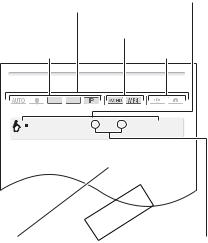
 indicates that a function is available in the operating mode indicated and
indicates that a function is available in the operating mode indicated and  indicates that the function is not available. The operating modes are divided into the following three groups. For a detailed explanation, refer to
indicates that the function is not available. The operating modes are divided into the following three groups. For a detailed explanation, refer to
Operating Modes (A39).
Brackets [ ] are used to refer to control buttons and menu options you will touch on the screen and to other onscreen messages and displays.
Movie format
Shooting mode |
Playback mode |
Self Timer
Operating modes:
 * SCN
* SCN
* For movies only.
 >[
>[
 Other Settings] >p>[Self Timer] >
Other Settings] >p>[Self Timer] >
[iOn <] >[X]
•<will appear on the screen.
•Repeat, selecting [jOff], to turn off the self timer.
Movies: In record pause mode, press Y.
The camcorder starts recording after a 10-second countdown. The countdown appears on the screen.
Photos: In record pause mode, touch [PHOTO].
• The camcorder will record the photo after a 10-second countdown. The |
|
|
COPY |
countdown appears on the screen. |
|
The names of physical buttons |
The >arrow is used to abbreviate menu selections. |
and switches on the |
For a detailed explanation on how to use the menus, |
camcorder are indicated within |
refer to Using the Menus (A35). For a concise |
a “button” frame. |
summary of all available menu options and settings, |
For example Y. |
refer to the appendix Menu Options Lists (A144). |
16 Introduction
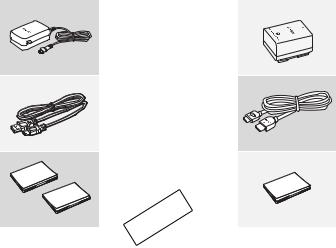
Supplied Accessories and CD-ROM
The following accessories are supplied with the camcorder:
XCA-110 Compact Power Adapter*
BP-718 Battery PackW
XIFC-300PCU/S USB Cable
HTC-100/S High Speed HDMI CableW
XQuick Guide
XWi-Fi Basic Setup Guide**
Transfer Utility LE Startup GuideW COPY(see below)
* CA-110E including power cord, in Asia. ** 6/4only.
Transfer Utility LE Startup Guide: This guide explains how to download PIXELA’s Transfer Utility LE software, which allows you to save your AVCHD movies and transfer music data from the supplied Canon VIXIA CD-ROM (see next page) to the camcorder. For details on using the software, refer to the Transfer Utility LE Software Guide included with the downloaded software.
 NOTES
NOTES
• The camcorder may make a rattling sound if it is shaken (A161).
Introduction 17

The Canon VIXIA CD-ROM is also supplied with the camcorder. The CDROM contains the following components:
-Instruction Manual - The full-version instruction manual of the camcorder (this PDF file).
-ImageBrowser EX - The CD-ROM contains an automatic installer for the software ImageBrowser EX, which allows you to save and manage MP4 movies and photos and upload CANON iMAGE GATEWAY*, YouTube and Facebook. An Internet connection is required for full installation of the software.
-Music data - Music files that can be used as background music during playback. These music files are for exclusive use with PIXELA’s software. The disc cannot be played back on CD players.
-Image mix data - Image files that can be used with the image mix function (image mix frames).
* CANON iMAGE GATEWAY is an online service that allows you to share movies and photos, make photo albums, and more. This service may not be available in all countries/regions.
COPY
18 Introduction
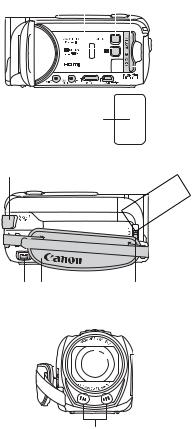
Names of Parts
Left side view
1 |
2 3 |
|
||||
|
|
|
|
|
|
|
|
|
|
|
|
|
|
|
|
|
|
|
|
|
|
|
|
|
|
|
|
|
|
|
|
|
|
|
|
|
|
|
|
|
|
4 56 |
7 |
|
8 |
Right side view
9
1  (playback mode) button (A40)
(playback mode) button (A40)
2 ON/OFF button (A23)
3 Memory card slot cover
4 MIC (microphone) terminal (A91)
5AV OUT terminal (A102, 104)/ ×(headphones) terminal (A89)
6 HDMI OUT terminal (A102, 103)
7 USB terminal (A102, 104)
8 Memory card slot (A29)
9 START/STOP button (A41) Aq DC IN terminal (A21)
aA Grip belt (A24)
As Lens cover switch (A25) Ad Stereo microphone (A87)
|
COPY |
Aq Aa |
As |
Front view
Ad
Introduction 19
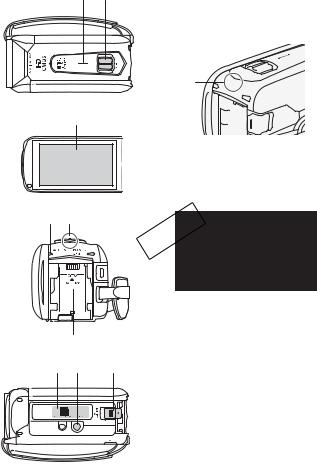
Top view
Af Ag
LCD panel
Ah
Back view
Aj Ak Al
Sq
Bottom view
Sa Ss |
Sd |
fA Speaker (A52) gA Zoom lever (A47)
hA LCD touch screen (A25, 35)
Aj ACCESS indicator (A41)
kA 64Wi-Fi antenna (A124)
Ak
lA POWER/CHG (charge) indicator: Green - On
Red - Charging (A21)
Sq Battery attachment unit (A21)
Sa Serial number
COPY
sS Tripod socket (A175)
dS BATTERY RELEASE switch (A22)
20 Introduction
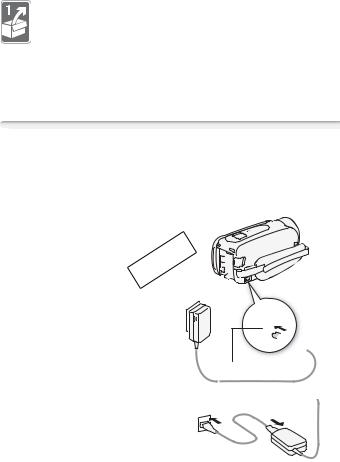
Preparations
This chapter describes basic operations, such as using the touch panel, navigating the menus, and first time settings to help you learn more about your camcorder.
Getting Started
Charging the Battery Pack
The camcorder can be powered with a battery pack or directly using the compact power adapter.
For approximate charging times and recording/playback times with a fully charged battery pack, refer to Charging, Recording and Playback Times (A181).
1Plug the power cord into a power outlet.
For Asia only: Connect theCOPYpower cord to the compact power adapter before plugging the power cord into the power outlet.
2Connect the compact power adapter to the camcorder’s DC IN terminal.
3Attach the battery pack to the camcorder.
Press the battery pack softly into the battery attachment unit and slide it up until it clicks in place.


DC IN terminal
For Asia only:
Preparations 21
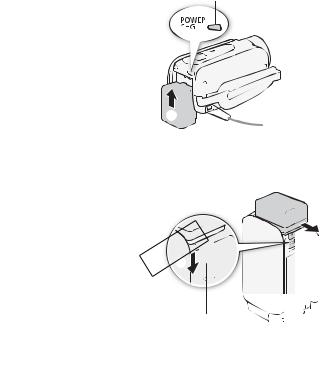
POWER/CHG (charge) indicator
4 Charging will start when the camcorder is turned off.
• If the camcorder was on, the green POWER/CHG indicator will go out when you turn off the camcorder. After a moment,
the POWER/CHG indicator will
turn on in red (battery pack 

 charging). The red POWER/
charging). The red POWER/ 


 CHG indicator will go out when
CHG indicator will go out when 
 the battery pack is fully
the battery pack is fully
charged.
• If the indicator flashes, refer to Troubleshooting (A
To remove the battery pack
1 Slide din the direction of the arrow and hold it pressed down.
2Slide the battery pack and then pull it out.
COPY




161).

BATTERY RELEASE switch
 IMPORTANT
IMPORTANT
•Turn off the camcorder before connecting or disconnecting the compact power adapter. After turning off the camcorder, important data is updated in the memory. Be sure to wait until the green POWER/CHG indicator goes out.
•Do not connect to the camcorder’s DC IN terminal or to the compact power adapter any electrical equipment that is not expressly recommended for use with this camcorder.
•To prevent equipment breakdowns and excessive heating, do not connect the supplied compact power adapter to voltage converters for
22 Preparations

overseas travels or special power sources such as those on aircraft and ships, DC-AC inverters, etc.
 NOTES
NOTES
•We recommend charging the battery pack in temperatures between 10 °C and 30 °C (50 °F and 86 °F). If either the ambient temperature or the battery pack’s temperature is outside the range of approx. 0 °C to 40 °C (32 °F to 104 °F), charging will not start.
•If the ambient temperature or the battery pack’s temperature is low, charging may take longer than usual.
•The battery pack will be charged only when the camcorder is off.
•If the power supply was disconnected while charging a battery pack, make sure the POWER/CHG indicator has gone out before restoring the power supply.
•If remaining battery time is an issue, you can power the camcorder using the compact power adapter so the battery pack will not be consumed.
•Charged battery packs continue to discharge naturally. Therefore, charge them on the day of use, or the day before, to ensure a full charge.
•Battery packs for this camcorderCOPYcan display the remaining battery time. The first time you use a battery pack, fully charge it and then use the camcorder until the battery pack is completely exhausted. Doing so will ensure that the remaining recording time will be displayed accurately.
•We recommend that you prepare battery packs to last 2 to 3 times longer than you think you might need.
•USA and Canada only: The Lithium ion/polymer battery that
powers the product is recyclable. Please call 




 1-800-8-BATTERY for information on how to recycle this
1-800-8-BATTERY for information on how to recycle this 
 battery.
battery. 






Turning On the Camcorder
You can turn the camcorder on and off by opening and closing the LCD panel. The first time you turn on the camcorder, the initial setup screens will appear and guide you through the basic settings (A31).
Preparations 23
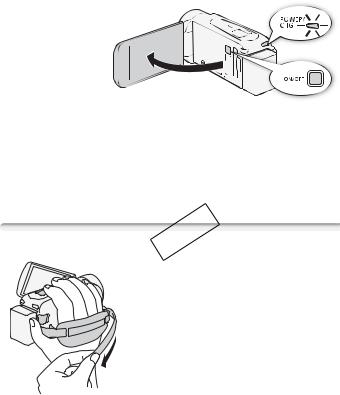
Open the LCD panel to turn on the camcorder.
To turn off the camcorder
Close the LCD panel or press  .
.
[
 NOTES
NOTES
•You can use the 
 >q>[Power On Using LCD Panel] setting so that you can turn the camcorder on and off only by pressing
>q>[Power On Using LCD Panel] setting so that you can turn the camcorder on and off only by pressing  .
.
Using the Grip Belt |
COPY |
|
|
|
Fasten the grip belt. |
Adjust the grip belt so that you can reach the zoom lever with your index finger, and the Ybutton with your thumb.
To remove the grip belt
1Lift the padded handgrip’s flap and detach the strap from the Velcro pad.
24 Preparations
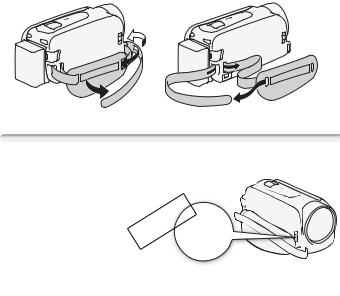
2Pull the strap to remove it first from the front bracket on the camcorder, then to unthread it from the handgrip and finally to remove it from the rear bracket on the camcorder.
Opening the Lens Cover and Adjusting the LCD Screen
Before you start recording, open the lens cover.
Move the lens cover switch down to  to open the lens cover.
to open the lens cover.
COPY






Rotating the LCD Panel
The first time you open the LCD panel, the initial setup screens will appear and guide you through the basic settings (A31).
Open the LCD panel 90 degrees.
•You can rotate the panel 90 degrees downward.
•You can rotate the panel 180 degrees toward the lens. Rotating the LCD panel 180 degrees can be useful to allow the camcorder to include yourself in the picture when recording with the self timer.
Preparations 25
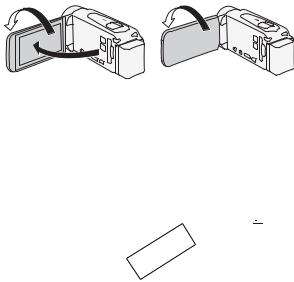
180° |
180° |
|
 Subject can monitor the LCD screen 90°
Subject can monitor the LCD screen 90°
 NOTES
NOTES
•About the LCD screen: The screen is produced using extremely high-pre- cision manufacturing techniques, with more than 99.99% of the pixels operating to specification. Less than 0.01% of the pixels may occasionally misfire or appear as black, red, blue or green dots. This has no effect on the recorded image and does not constitute a malfunction.
•For details about how to take care of the touch screen, refer to Handling Precautions (A174), Cleaning (A178).
•You can adjust the screen’s brightness using the 
 >
>  >[LCD Brightness] and [LCD Backlight] settings. When the compact power adapter is connected, [LCD Backlight]COPYwill automatically change to
>[LCD Brightness] and [LCD Backlight] settings. When the compact power adapter is connected, [LCD Backlight]COPYwill automatically change to
[H Bright].
26 Preparations
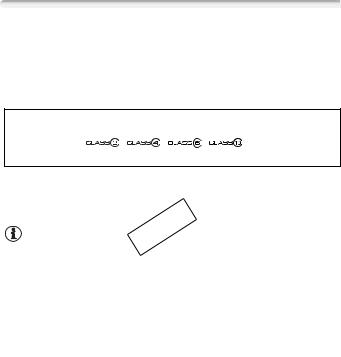
Using a Memory Card
Memory Cards Compatible for Use with the Camcorder
You can use the following types of commercially available Secure Digital (SD) cards with this camcorder.
As of January 2013, the movie recording function has been tested using SD/SDHC/SDXC memory cards made by Panasonic, Toshiba and SanDisk. For the latest information on cards that can be used, visit your local Canon Web site.
Memory card type: .SD memory card, /SDHC memory card, 0SDXC memory card
SD Speed Class*: |
|
Capacity: |
128 MB or larger**. |
* When using an SD memory card without a speed class rating, you may not be able to record movies, depending on the memory card used.
**SD memory cards with a capacity of 64 MB or smaller cannot be used to record movies.
•About the Speed Class: SpeedCOPYClass is a standard that indicates the minimum guaranteed data transfer speed of memory cards. When you buy a new memory card, look for the Speed Class logo on the package.
When you record movies with a video quality of 60P or 35 Mbps, we recommend using memory cards rated SD Speed Class 6 or 10. When you record movies with other video quality options, we recommend using memory cards rated SD Speed Class 4, 6 or 10.
SDXC Memory Cards
You can use SDXC memory cards with this camcorder. When using memory cards with other devices, such as digital recorders, computers and card readers, make sure that the external device is compatible with SDXC cards. For more information on compatibility, contact the computer, operating system or memory card manufacturer.
Preparations 27

 IMPORTANT
IMPORTANT
•If you use an SDXC memory card with a computer OS that is not SDXCcompatible, you may be prompted to format the memory card. In such case, cancel the operation to prevent data loss.
•After repeatedly recording, deleting and editing scenes (fragmented memory), it will take longer to write data on the memory and recording may stop. Save your recordings and initialize the memory.
COPY
28 Preparations
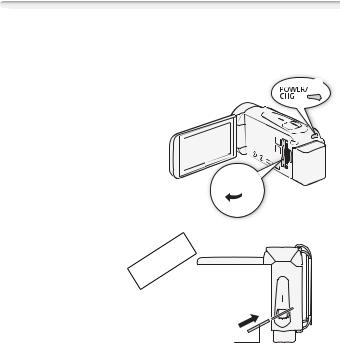
Inserting and Removing a Memory Card
If you plan on using a memory card, turn off the camcorder before performing the initial setup and then insert the memory card. After performing the initial setup, initialize the memory card (A33).
1Open the LCD panel.
If this is your first time to turn on the camcorder, the language selection screen of the initial setup screens will appear.
2 Press  to turn off the camcorder.
to turn off the camcorder.
Make sure the POWER/CHG indicator is off.
3 Open the memory card slot |
|
|
|
|
|
||
cover. |
|
|
|
4 Insert the memory card at a |
|
|
|
slight angle, with the label |
|
|
|
|
COPY |
|
|
facing toward the lens, all the |
|
|
|
way into the memory card slot |
|
|
|
until it clicks. |
|
|
|
The memory card slot is at a |
|
|
|
slight angle toward the lens so |
|
|
|
be careful not to damage the |
|
|
|
memory card when inserting it. |
Memory card |
|
|
|
|
|
|
5Close the memory card slot cover.
Lens
Top view
Do not force the cover closed if the memory card is not correctly inserted.
To remove the memory card
Push the memory card once to release it. When the memory card springs out, pull it all the way out.
Preparations 29

 IMPORTANT
IMPORTANT
•Memory cards have front and back sides that are not interchangeable. Inserting a memory card facing the wrong direction can cause a malfunction of the camcorder. Be sure to insert the memory card as described in step 4.
COPY
30 Preparations
